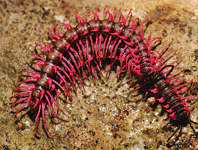Abstract
The Southeast Asian species of Hypsugo are rare bats, except for H. cadornae and H. pulveratus, which are distributed throughout the Indomalayan region. Hypsugo macrotis is restricted to Peninsular Malaysia, Sumatra, Java and adjacent islands, and is known only from a handful of specimens. Here we report a new locality record of the species from Seremban, Peninsular Malaysia, which also represents the first known building-dweller colony of any Hypsugo from the region. We discuss the taxonomic status of two morphologically similar species, H. macrotis and H. vordermanni, and provide the first COI and cyt b gene sequences for H. macrotis and reconstruct the species’ phylogenetic relationships.
References
Bates, P.J.J. & Harrison, D.L. (1997) Bats of the Indian Subcontinent. Harrison Zoological Museum, Sevenoaks, Kent, 258 pp.
Chasen, F.N. (1940) A handlist of Malaysian mammals (A systematic list of the mammals of the Malay Peninsula, Sumatra, Borneo and Java, including the adjacent small islands). Bulletin of the Raffles Museum, 15, 1–209.
Corbet, G.B. & Hill, J.E. (1992) The mammals of the Indomalayan Region: a systematic review. Natural History Museum Publications and Oxford University Press, New York, 496 pp.
Csorba, G., Görföl, T., Wiantoro, S., Kingston, T., Bates, P.J.J. & Huang, J.C.-C. (2015) Thumb-pads up—a new species of thick-thumbed bat from Sumatra (Chiroptera: Vespertilionidae: Glischropus). Zootaxa, 3980 (2), 267–278.
http://dx.doi.org/10.11646/zootaxa.3980.2.7
Ellerman, J.R. & Morrison-Scott, T.C.S. (1951) Checklist of Palearctic and Indian mammals 1758 to 1946. British Museum (Natural History), London, 810 pp.
http://dx.doi.org/10.1126/science.115.2990.431
Francis, C.M., Borisenko, A.V., Ivanova, N.V., Eger, J.L., Lim, B.K., Guillen-Servent, A., Kruskop, S.V., Mackie, I. & Hebert, P.D.N. (2010) The role of DNA barcodes in understanding and conservation of mammal diversity in Southeast Asia. PLoS ONE, 5, e12575.
http://dx.doi.org/10.1371/journal.pone.0012575
Francis, C. & Hill, J. E. (1986) A review of the Bornean Pipistrellus (Mammalia: Chiroptera). Mammalia, 50, 43–56.
http://dx.doi.org/10.1515/mamm.1986.50.1.43Francis, C.M. (2008) A field guide to the mammals of South-east Asia. New Holland Publishers, London, 392 pp.
Galimberti, A., Spada, M., Russo, D., Mucedda, M., Angelli, P., Crottini, A., Ferri, E., Martinoli, A. & Casiraghi, M. (2012) Integrated Operational Taxonomic Units (IOTUs) in echolocating bats: a bridge between molecular and traditional taxonomy. PLoS ONE, 7, e40122.
http://dx.doi.org/10.1371/journal.pone.0040122
Goodman, S.M., Rakotondramanana, C.F., Ramasindrazana, B., Kearney, T., Monadjem, A., Schoeman, M.C., Taylor, P.J., Naughton K. & Appleton, B. (2015) An integrative approach to characterize Malagasy bats of the subfamily Vespertilioninae Gray, 1821, with the description of a new species of Hypsugo. Zoological Journal of the Linnean Society, 173, 988–1018.
http://dx.doi.org/10.1111/zoj.12223
Görföl, T., Csorba, G., Eger, J.L., Son, N.T. & Francis, C.M. (2014) Canines make the difference: a new species of Hypsugo (Chiroptera: Vespertilionidae) from Laos and Vietnam. Zootaxa, 3887 (2), 239–250.
http://dx.doi.org/10.11646/zootaxa.3887.2.6
Happold, M. & Happold, D.C.D. (2013) Volume IV: Hedgehogs, Shrews and Bats. In: Kingdon, J., Happold, D., Butynski, T., Hoffmann, M., Happold, M. & Kalina, J. (Eds.), Mammals of Africa (6 vols). Bloomsbury Publishing, London, pp. 1–800. http://dx.doi.org/10.1007/s10914-014-9269-2
Hasegawa, M., Kishino, H. & Yano, T. (1985) Dating the human-ape split by a molecular clock of mitochondrial DNA. Journal of Molecular Evolution, 22, 160–174.
Heaney, L.R., Balete, D.S., Alviola, P., Rickart, E.A. & Ruedi, M. (2012) Nyctalus plancyi and Falsistrellus petersi (Chiroptera: Vespertilionidae) from northern Luzon, Philippines: ecology, phylogeny, and biogeographic implications. Acta Chiropterologica, 14, 265–278.
http://dx.doi.org/10.3161/150811012X661602
Ivanova, N.V., Zemlak, T.S., Hanner, R.H. & Hebert, P.D.N. (2007) Universal primer cocktails for fish DNA barcoding. Molecular Ecology Resources, 7, 544–548.
http://dx.doi.org/10.1111/j.1471-8286.2007.01748.x
Khan, F.A.A., Solari, S., Swier, V.J., Larsen, P.A., Abdullah, M.T., & Baker, R.J. (2010) Systematics of Malaysian woolly bats (Vespertilionidae: Kerivoula) inferred from mitochondrial, nuclear, karyotypic, and morphological datasets. Journal of Mammalogy, 19, 1058–1072.
http://doi.org/10.1644/09-MAMM-A-361.1
Kim, J.Y. & Park, Y.C. (2015) Gene organization and characterization of the complete mitogenome of Hypsugo alaschanicus (Chiroptera: Vespertilionidae). Genetics and Molecular Research, 14, 16325–16331.
http://dx.doi.org/10.4238/2015.December.8.24
Kimura, M. (1980) A simple method for estimating evolutionary rate of base substitutions through comparative studies of nucleotide sequences. Journal of Molecular Evolution, 16, 111-120.
Koopman, K.F. (1994) Chiroptera: Systematics. In: Niethammer, J., Schliemann, H. & Starck, D., (Eds), Handbook of Zoology. Walter de Gruyter, Berlin and New York, pp. 1–217.
Lê, S., Josse, J. & Husson, F. (2008) FactoMineR: An R package for multivariate analysis. Journal of Statistical Software, 25, 1–18.
http://dx.doi.org/10.18637/jss.v025.i01
McKenzie, N.L., Gunnell, A.C., Yani, M. & Williams, M.R. (1995) Correspondence between flight morphology and foraging ecology in some Paleotropical bats. Australian Journal of Zoology, 43, 241–257.
Medway, L. 1978. The wild mammals of Malaya (Peninsular Malaysia) and Singapore. Oxford University Press, Kuala Lumpur, 156 pp.
R Core Team (2014) R: A language and environment for statistical computing. R Foundation for Statistical Computing, Vienna. Available from http://www.R-project.org (accessed 6 November 2014)
Sikes, R.S., Gannon, W.L. & Animal Care and Use Committee of the American Society of Mammalogists (2011) Guidelines of the American Society of Mammalogists for the use of wild mammals in research. Journal of Mammalogy, 92, 235–253.
http://dx.doi.org/10.1644/10-MAMM-F-355.1
Simmons, N.B. (2005) Order Chiroptera. In: Wilson, D.E. & Reeder, D.M. (Eds), Mammal Species of the World. A Taxonomic and Geographic Reference. The Johns Hopkins University Press, Baltimore, 3rd edition, pp. 312–529.
Stadelmann, B., Herrera, L.G., Arroyo-Cabrales, J., Flores-Martínez, J.J., May, B.P. & Ruedi, M. (2004) Molecular systematics of the fishing bat Myotis (Pizonyx) vivesi. Journal of Mammalogy, 85, 133–139.
http://dx.doi.org/10.1644/1545-1542(2004)085<0133:MSOTFB>2.0.CO;2
Tamura, K., Stecher, G., Peterson, D., Filipski, A., & Kumar, S. (2013) MEGA6: Molecular Evolutionary Genetics Analysis Version 6.0. Molecular Biology and Evolution, 30, 2725–2729.
http://dx.doi.org/10.1093/molbev/mst197
Tate, G.H.H. (1942) Results of the Archbold Expeditions 47. Review of the vespertilionine bats, with special attention to genera and species of the Archbold Expeditions. Bulletin of the American Museum of Natural History, 80, 221–297.
Temminck, P.C.J. (1840) Monographies de Mammalogie, ou description de quelques genres de mammifères, dont les espèces ont étè observées dans les différens musées de l’Europe, 2 tome. Chez C.C. van der Hoek, et a Paris, Chez Ed. D’Ocagne, et A. Bertrand, Leiden, pp. 392.
Woodruff, D.S. & Turner, L.M. (2009) The Indochinese-Sundaic zoogeographic transition: a description and analysis of terrestrial mammal species distributions. Journal of Biogeography, 36, 803–821.
http://dx.doi.org/10.1111/j.1365-2699.2008.02071.x

